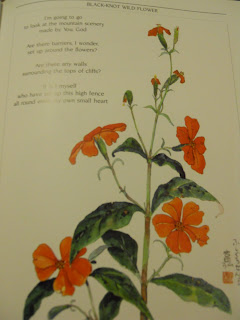
I enjoy poetry and have a special appreciation for things Japanese so I found reading this little haiku and short poems quite fun. I enjoyed sharing a couple of them with family members too. The paintings were delightful, but I was just reading bits and pieces of the pretty poetry book I found at the resale shop.
It actually took me a while to discover Tomihiro's special ability of painting and writing with a tool in his teeth. As I read more, I discovered he was paralyzed and not only that, he was a Christian. No wonder that I found him to write with humility and honestly. I began to reread some of my favorites and even beginin reading the poetry book from the begining of the book. I enjoyed the personal insights into Tomihiro's personal and thoughtful world.
Tomihiro was born in Japan in 1946. He was an avid gymnast there, even a coach until an accident in 1970 left him paralyzed from the neck down. He spent nine years hospitalized, relearning how to live and how to use the brush in his mouth to write and paint.
THis is a great book. It sheds heavenly light on a personal journey, one of perseverance in the darkness of a great difficulty and what could possibly even be despair. It's a peek into the world of flowers and the thoughts they weave into a tiny eye tha dares to contemplate the world, as it spins it;s own tale of a miracle into all of creation....at least this is my explanation of the experience of reading through this book.
The title of the book comes from the gift of a bell that Hoshino was given... and the lessson he learned.
Someone gave him a small bell and he tied this bell onto his wheelchair where he noticed that he didn;t hear it until he traveled the rough surfaced roads and pathways. He then related this tinkling bell to the idea that in the journey of life, it is when we go down the uneven roads of hardship and difficulty, the more outback terrain, (much like Tomihiro's wheelchair,) that we hear the important things, see the miraculous and even consider who we are and what life is about. It's the little things that reveal the miraculous.... something that simply makes a noise and gets your attention.
You will not hear the tinkling bell, when things are perfect and the road is smooth. It cannot jingle, then, except maybe in the wind. A bump in the road is an opportunity to hear the little bell that rings to get our attention, to comfort us reminding us, we are not alone.
The sound of a bell, a tinkling bell is beautiful indeed.
and so... off we go, down the road of the tinkling bell.




